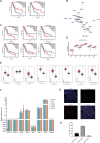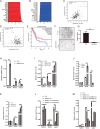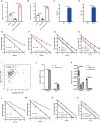METTL16 inhibits pancreatic cancer proliferation and metastasis by promoting MROH8 RNA stability and inhibiting CAPN2 expression - experimental studies
- PMID: 39434688
- PMCID: PMC11634154
- DOI: 10.1097/JS9.0000000000002116
METTL16 inhibits pancreatic cancer proliferation and metastasis by promoting MROH8 RNA stability and inhibiting CAPN2 expression - experimental studies
Abstract
Background: N6-methyladenosine (m6A) modification plays a crucial role in the progression of various cancers, including pancreatic cancer, by regulating gene expression. However, the specific mechanisms by which m6A affects pancreatic cancer metastasis remain unclear. This study aims to elucidate the role of METTL16, an m6A writer gene, in regulating core genes such as CAPN2 and MROH8, influencing tumor growth and metastasis.
Materials and methods: Transcriptomic data from pancreatic cancer patients in The Cancer Genome Atlas (TCGA) were analyzed to identify m6A-related genes. We performed correlation and survival analyses to uncover core genes influenced by m6A expression. Functional assays, including METTL16 knockdown and overexpression experiments, were conducted in pancreatic cancer cell lines, patient-derived organoids, and animal models. Immunofluorescence, co-immunoprecipitation (Co-IP), and m6A-specific quantitative PCR were used to validate protein interactions and m6A modifications. Chromatin immunoprecipitation (ChIP) analysis was utilized to investigate transcription factor binding at gene promoter regions.
Results: METTL16 and METTL3 were identified as key m6A regulators associated with improved prognosis in pancreatic cancer patients ( P <0.05). CAPN2, CHMP2B, ITGA3, ITGA6, ITPR1, and RAC1 were identified as core genes linked to m6A expression, all significantly correlated with patient prognosis ( P <0.05). METTL16 overexpression significantly inhibited tumor growth and metastasis ( P <0.001) by downregulating CAPN2 through an indirect mechanism involving the transcription factor TBP and the gene MROH8. MROH8 negatively regulated CAPN2 by promoting TBP degradation, with METTL16 enhancing MROH8 mRNA stability through m6A modifications ( P <0.01). Functional assays demonstrated that METTL16 and YTHDC2 (an m6A reader) collaboratively enhanced MROH8 mRNA stability, thereby inhibiting CAPN2 expression and reducing tumor proliferation and metastasis ( P <0.001).
Conclusion: This study reveals a novel regulatory axis involving METTL16, MROH8, and TBP that modulates CAPN2 expression, contributing to the suppression of pancreatic cancer progression. The METTL16-MROH8-TBP-CAPN2 pathway offers potential therapeutic targets for pancreatic cancer treatment, highlighting the significance of m6A modifications in tumor regulation. Further clinical validation is needed to confirm these findings in human patients.
Copyright © 2024 The Author(s). Published by Wolters Kluwer Health, Inc.
Conflict of interest statement
The authors declare no conflicts of interest.
Sponsorships or competing interests that may be relevant to content are disclosed at the end of this article.
Figures










References
MeSH terms
Substances
LinkOut - more resources
Full Text Sources
Medical
Research Materials
Miscellaneous

